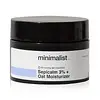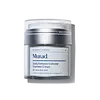What's inside
What's inside
 Key Ingredients
Key Ingredients

 Benefits
Benefits

 Concerns
Concerns

 Ingredients Side-by-side
Ingredients Side-by-side

Water
Skin ConditioningAvena Sativa Kernel Extract
AbrasiveSqualane
EmollientGlycerin
HumectantXylitylglucoside
HumectantAnhydroxylitol
HumectantXylitol
HumectantSodium Cocoyl Amino Acids
CleansingSarcosine
Skin ConditioningPotassium Aspartate
Skin ConditioningMagnesium Aspartate
Skin ConditioningCaprylic/Capric Triglyceride
MaskingPanthenol
Skin ConditioningPentylene Glycol
Skin ConditioningAvena Sativa Kernel Flour
AbrasiveSodium Polyglutamate
HumectantUndecane
EmollientButyrospermum Parkii Butter
Skin ConditioningTocopheryl Acetate
AntioxidantArginine
MaskingGlycine
BufferingAlanine
MaskingHistidine
HumectantSodium Lactate
BufferingArachidyl Alcohol
EmollientBehenyl Alcohol
EmollientArachidyl Glucoside
EmulsifyingTridecane
PerfumingAluminum Starch Octenylsuccinate
AbsorbentTrehalose
HumectantPolyacrylate Crosspolymer-6
Emulsion StabilisingPhenoxyethanol
PreservativeEthylhexylglycerin
Skin ConditioningCitric Acid
BufferingTrisodium Ethylenediamine Disuccinate
Water, Avena Sativa Kernel Extract, Squalane, Glycerin, Xylitylglucoside, Anhydroxylitol, Xylitol, Sodium Cocoyl Amino Acids, Sarcosine, Potassium Aspartate, Magnesium Aspartate, Caprylic/Capric Triglyceride, Panthenol, Pentylene Glycol, Avena Sativa Kernel Flour, Sodium Polyglutamate, Undecane, Butyrospermum Parkii Butter, Tocopheryl Acetate, Arginine, Glycine, Alanine, Histidine, Sodium Lactate, Arachidyl Alcohol, Behenyl Alcohol, Arachidyl Glucoside, Tridecane, Aluminum Starch Octenylsuccinate, Trehalose, Polyacrylate Crosspolymer-6, Phenoxyethanol, Ethylhexylglycerin, Citric Acid, Trisodium Ethylenediamine Disuccinate
Colloidal Oatmeal 1%
AbsorbentWater
Skin ConditioningGlycerin
HumectantButyrospermum Parkii Butter
Skin ConditioningPropanediol
SolventCaprylic/Capric Triglyceride
MaskingGlyceryl Stearate
EmollientAvena Sativa Kernel Flour
AbrasiveAvena Sativa Kernel Extract
AbrasiveBetaine
HumectantOphiopogon Japonicus Root Extract
Skin ConditioningNiacinamide
SmoothingHydrogenated Lecithin
EmulsifyingEthylhexylglycerin
Skin ConditioningMaltodextrin
AbsorbentCetearyl Alcohol
EmollientCetearyl Glucoside
EmulsifyingLauryl Laurate
Skin ConditioningCetyl Myristate
EmollientSodium Polyacrylate Starch
AbsorbentCarbomer
Emulsion StabilisingHectorite
AbsorbentCaprylhydroxamic Acid
Tetrasodium Glutamate Diacetate
Sodium Hydroxide
BufferingChlorphenesin
AntimicrobialColloidal Oatmeal 1%, Water, Glycerin, Butyrospermum Parkii Butter, Propanediol, Caprylic/Capric Triglyceride, Glyceryl Stearate, Avena Sativa Kernel Flour, Avena Sativa Kernel Extract, Betaine, Ophiopogon Japonicus Root Extract, Niacinamide, Hydrogenated Lecithin, Ethylhexylglycerin, Maltodextrin, Cetearyl Alcohol, Cetearyl Glucoside, Lauryl Laurate, Cetyl Myristate, Sodium Polyacrylate Starch, Carbomer, Hectorite, Caprylhydroxamic Acid, Tetrasodium Glutamate Diacetate, Sodium Hydroxide, Chlorphenesin
Ingredients Explained
These ingredients are found in both products.
Ingredients higher up in an ingredient list are typically present in a larger amount.
Avena Sativa Kernel Extract is is derived from colloidal oatmeal. Besides being a healthy breakfast, oats have many benefits in skincare too.
This ingredient helps sooth, hydrate, and protect the skin. The starches in colloidal oatmeal are able to bind water, keeping the skin hydrated.
The cellulose and fiber in colloidal oatmeal help reduce inflammation. This can also help the skin feel softer.
Colloidal Oatmeal is also an antioxidant. Antioxidants protect our skin from free-radical damage.
Oatmeal also contains beneficial compounds:
This ingredient is created by mixing grounded oatmeal and a liquid base.
Learn more about Avena Sativa Kernel ExtractOatmeal flour is created by grinding down the kernels of oats. Oatmeal helps sooth, hydrate, and protect the skin.
Oatmeal kernel flour has abrasive, or exfoliating, properties.
Learn all about the skin benefits of colloidal oatmeal here.
Learn more about Avena Sativa Kernel FlourThis ingredient is also known as shea butter. It is an effective skin hydrator and emollient.
Emollients help soothe and soften your skin. It does this by creating a protective film on your skin. This barrier helps trap moisture and keeps your skin hydrated. Emollients may be effective at treating dry or itchy skin.
Shea butter is rich in antioxidants. Antioxidants help fight free-radicals, or molecules that may harm the body. It is also full of fatty acids including stearic acid and linoleic acid. These acids help replenish the skin and keep skin moisturized.
While Shea Butter has an SPF rating of about 3-4, it is not a sunscreen replacement.
Shea butter may not be fungal acne safe. We recommend speaking with a professional if you have any concerns.
Learn more about Butyrospermum Parkii ButterThis ingredient is an emollient, solvent, and texture enhancer. It is considered a skin-softener by helping the skin prevent moisture loss.
It helps thicken a product's formula and makes it easier to spread by dissolving clumping compounds.
Caprylic Triglyceride is made by combining glycerin with coconut oil, forming a clear liquid.
While there is an assumption Caprylic Triglyceride can clog pores due to it being derived from coconut oil, there is no research supporting this.
Learn more about Caprylic/Capric TriglycerideEthylhexylglycerin (we can't pronounce this either) is commonly used as a preservative and skin softener. It is derived from glyceryl.
You might see Ethylhexylglycerin often paired with other preservatives such as phenoxyethanol. Ethylhexylglycerin has been found to increase the effectiveness of these other preservatives.
Glycerin is already naturally found in your skin. It helps moisturize and protect your skin.
A study from 2016 found glycerin to be more effective as a humectant than AHAs and hyaluronic acid.
As a humectant, it helps the skin stay hydrated by pulling moisture to your skin. The low molecular weight of glycerin allows it to pull moisture into the deeper layers of your skin.
Hydrated skin improves your skin barrier; Your skin barrier helps protect against irritants and bacteria.
Glycerin has also been found to have antimicrobial and antiviral properties. Due to these properties, glycerin is often used in wound and burn treatments.
In cosmetics, glycerin is usually derived from plants such as soybean or palm. However, it can also be sourced from animals, such as tallow or animal fat.
This ingredient is organic, colorless, odorless, and non-toxic.
Glycerin is the name for this ingredient in American English. British English uses Glycerol/Glycerine.
Learn more about GlycerinWater. It's the most common cosmetic ingredient of all. You'll usually see it at the top of ingredient lists, meaning that it makes up the largest part of the product.
So why is it so popular? Water most often acts as a solvent - this means that it helps dissolve other ingredients into the formulation.
You'll also recognize water as that liquid we all need to stay alive. If you see this, drink a glass of water. Stay hydrated!
Learn more about Water